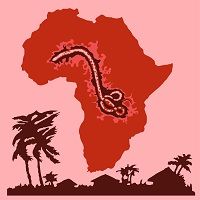WHO Ebola Virus Disease Definitions Are Suboptimal, Study Shows
Ebola virus disease definitions from the World Health Organization definitions could be improved by including contact history and intense fatigue as a key symptom and excluding fever, a new study found.

The ability to accurately identify Ebola cases is crucial to curtailing the disease. A new study by an international team of investigators found that Ebola virus disease definitions from the World Health Organization were suboptimal, leading to an inability to distinguish Ebola from more common diseases such as malaria and typhoid fever and resulting in challenges to treatment and risk mitigation.
The definitions could be improved by including intense fatigue as a key symptom and contact history and excluding fever, a new study found.
The review, published in The Lancet Infectious Diseases, involved searching studies published between June 13, 1978, and Jan 14, 2020. Fourteen studies from 4 countries were included, representing 12,021 suspected cases of Ebola, of which 4,874 were confirmed. Investigators evaluated WHO virus disease case definitions, clinical and epidemiological characteristics and predictive risk scores.
Pooled sensitivity, which measures the true positive rate or the ability accurately identify those with the disease, was 81.5%, and specificity, which measures the true negative rate or ability to identify those without the disease, was 35.7%.
“The low specificity results in high numbers of false positives and thus potentially unnecessary admissions to Ebola treatment centres, with associated risk of nosocomial transmission and costs of managing suspected cases,” the study noted. “As a consequence, a large number of people who do not have Ebola virus disease will experience unnecessary invasive procedures, risk of being infected with Ebola virus, isolation from family, fear of being stigmatised, and delay to appropriate care, and community mistrust in response activities will increase.”
Excluding fever from the case definition at the community level could improve the sensitivity, according to the study, which noted that fever was absent in at least 10% of cases of the 2014-2016 West Africa outbreak. Fever had a specificity of 25%, which went up to 82.6% when defined as a threshold at 38.5°C or more.
Intense fatigue had a sensitivity of 79%, making it the symptom with greatest sensitivity. Including this symptom in the definition could help health care workers more accurately refer suspected cases to treatment centers and prevent transmission in the community.
Conjunctivitis, unexplained bleeding and difficulty swallowing all had specificity greater than 80% and, along with diarrhea, had the best discriminatory accuracy. However, they appear at the late stage of the disease.
The study found that pediatric and pregnant patients might require definitions that are adapted to consider their specific characteristics. The WHO pediatric definition had a sensitivity of 98% and specificity of 5%. Those results were reversed to 23% and 97% respectively for a subdefinition that included contact, fever, and conjunctivitis, or contact, fever, anorexia, and two of abdominal pain, diarrhea, or male sex older than 2.
The study noted that 25% of children assessed in one study were afebrile. The study also noted that pregnant women with complications may exhibit signs such as bleeding and abdominal pain that mimic Ebola virus disease.
History of contact with infected people was a strong predictor of disease, the study found, but it noted that this factor depends on high levels of community engagement and trust in health care workers.
“In conclusion, this first systematic review and meta-analysis of the strengths and limitations of the WHO Ebola virus disease case definitions highlights the need for further studies to assess consistent thresholds for fever, to explore viraemia and symptoms and signs at admission, and to externally validate risk scores for Ebola virus infection,” the authors noted. “The sensitivity and specificity of WHO Ebola case definitions could be improved by excluding fever and instead including both intense fatigue and history of contact. However, reliable disclosure of reported symptoms and history of contact requires effective collaboration with, and the trust of, affected communities. To achieve this trust and collaboration, responding organisations must recognise the paramount role of communities in controlling transmission and ending outbreaks.”
The World Health Organization reported a new outbreak of Ebola in the port city Mbandaka in the Democratic Republic of the Congo, with an initial 6 cases and 4 deaths. This 11th outbreak began as the 10th outbreak in the Kivu region ended after killing more than 2,260 people.
The European Commission granted Janssen Pharmaceutical Companies marketing authorization for a 2-dose regimen of Ebola vaccine.
